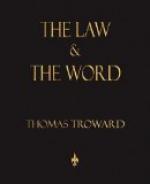As I have said, I had no reason at that time to suppose I should ever go to Scotland, but some weeks later I was invited to lecture in Edinburgh. Another visitor in the house where I was a guest there, was the wife of the County Court Judge of Cumberland, and I showed her and our hostess the part of the Latin inscription I had retained, and suggested that perhaps it might exist somewhere in Edinburgh. However nothing answering to what I had seen was to be found, so we relegated the whole thing to the region of unaccountable fancies, and thought no more about it. The Judge’s wife took her departure before me, and kindly invited me to spend a few days at their residence near Carlisle on my return journey, which I did. One day she drove me out to see Lanercost Abbey, one of the show-places of the neighbourhood, and walking round the building I found in one of the walls the Latin inscription in question. I called Mrs. ——, who was a little way off, and said: “Look at this inscription.”
She at once replied: “Why! that is the very inscription we were all puzzling over in Edinburgh!”
It turned out to be an inscription in memory of the founder of the abbey, dating from somewhere in the eleven-hundreds. The whole place answered exactly to what I had seen, and the long low parsonage was there also.
“I should have liked you to see it inside,” said Mrs. ——, “but I have never met the vicar, though I know his mother-in-law, so we must give it up.”
We were just entering our carriage when the garden-gate opened, and who should come out but the mother-in-law.
“Oh, Mrs. ——,” she said, addressing the Judge’s wife, “I am here on a visit and you must come in and take tea.” So we went in and were shown over the house, much as I had been in my vision, and some portions were so old that, among other rooms, we were shown the one occupied by King Edward I on his march against Scotland in the year 1296, when the Scottish regalia was captured, and the celebrated Crowning-Stone was brought to England and placed in Westminster Abbey, where it has ever since remained—a stone having an occult relation to the history of the British and American peoples of the highest interest to both, but as there is already an extensive literature on this subject I will not enter upon it here.




